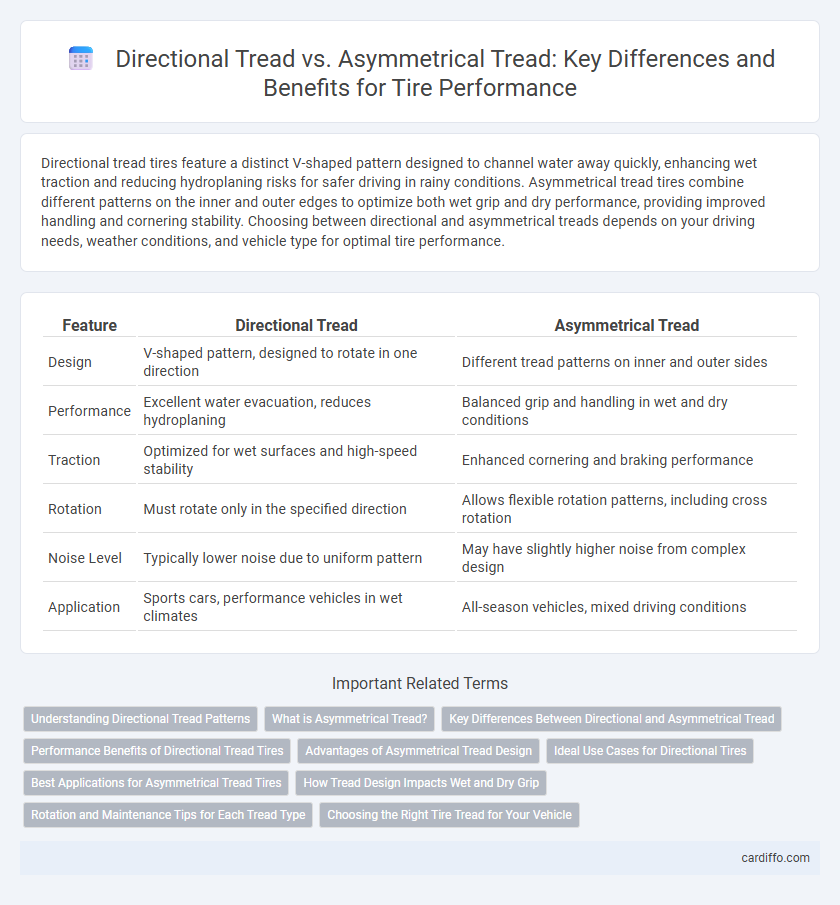Directional tread tires feature a distinct V-shaped pattern designed to channel water away quickly, enhancing wet traction and reducing hydroplaning risks for safer driving in rainy conditions. Asymmetrical tread tires combine different patterns on the inner and outer edges to optimize both wet grip and dry performance, providing improved handling and cornering stability. Choosing between directional and asymmetrical treads depends on your driving needs, weather conditions, and vehicle type for optimal tire performance.
Table of Comparison
| Feature | Directional Tread | Asymmetrical Tread |
|---|---|---|
| Design | V-shaped pattern, designed to rotate in one direction | Different tread patterns on inner and outer sides |
| Performance | Excellent water evacuation, reduces hydroplaning | Balanced grip and handling in wet and dry conditions |
| Traction | Optimized for wet surfaces and high-speed stability | Enhanced cornering and braking performance |
| Rotation | Must rotate only in the specified direction | Allows flexible rotation patterns, including cross rotation |
| Noise Level | Typically lower noise due to uniform pattern | May have slightly higher noise from complex design |
| Application | Sports cars, performance vehicles in wet climates | All-season vehicles, mixed driving conditions |
Understanding Directional Tread Patterns
Directional tread patterns feature V-shaped grooves designed to channel water away efficiently, enhancing wet traction and reducing hydroplaning risks. Unlike asymmetrical treads that combine different patterns for varied handling, directional treads optimize performance for a specific rotational direction, improving stability and grip at high speeds. This tread design is ideal for drivers seeking enhanced wet-weather performance and precise steering response.
What is Asymmetrical Tread?
Asymmetrical tread features different patterns across the inner and outer sections of the tire to optimize performance, with the inner designed for water dispersion and the outer providing cornering grip. This tread design enhances handling, traction, and safety in diverse driving conditions, making it ideal for high-performance and everyday vehicles. Unlike directional treads, asymmetrical tires can be mounted in multiple orientations, increasing flexibility in tire rotation and maintenance.
Key Differences Between Directional and Asymmetrical Tread
Directional tread tires feature a V-shaped pattern designed to channel water away efficiently, enhancing wet traction and reducing hydroplaning risks. Asymmetrical tread tires combine different tread patterns on the inner and outer sections to optimize grip, handling, and wear, providing a balance between wet and dry performance. Key differences include the specific rotation requirement for directional tires, while asymmetrical tires offer more versatile mounting options without a fixed rotation direction.
Performance Benefits of Directional Tread Tires
Directional tread tires enhance hydroplaning resistance and provide superior traction on wet surfaces due to their V-shaped tread pattern designed to channel water efficiently. Their optimized grip improves handling and stability at high speeds, making them ideal for performance vehicles and aggressive driving conditions. The tread design also promotes better self-cleaning properties, maintaining consistent performance on loose surfaces like mud or snow.
Advantages of Asymmetrical Tread Design
Asymmetrical tread designs offer enhanced handling and improved grip by combining different tread patterns on the inner and outer sections, optimizing performance for both wet and dry conditions. The inner tread promotes water dispersion to reduce hydroplaning, while the outer tread provides increased cornering stability and traction. These tires typically deliver a quieter and more comfortable ride, making them ideal for versatile driving environments.
Ideal Use Cases for Directional Tires
Directional tires excel in high-performance driving and wet conditions due to their V-shaped tread pattern that efficiently channels water away, reducing the risk of hydroplaning. They are ideal for sports cars and vehicles frequently driven on wet or snowy roads where enhanced traction and stability at higher speeds are critical. Their design is best suited for one-directional rotation, optimizing grip and handling for aggressive driving styles.
Best Applications for Asymmetrical Tread Tires
Asymmetrical tread tires offer enhanced traction and handling by combining varied tread patterns on the inner and outer sections, making them ideal for high-performance vehicles and sporty driving. These tires excel on dry and wet roads, providing improved cornering and stability due to their optimized block placement and siping. They are best suited for drivers seeking a balance between grip, comfort, and all-season performance in both everyday and spirited driving conditions.
How Tread Design Impacts Wet and Dry Grip
Directional tread patterns channel water efficiently through V-shaped grooves, enhancing wet grip by reducing hydroplaning risks, while providing stability and precise handling on dry surfaces. Asymmetrical tread designs combine varied tread blocks and sipes to optimize dry cornering performance and wet traction, balancing grip and durability. Tire manufacturers utilize these tread designs to tailor performance based on driving conditions, ensuring optimal safety and control.
Rotation and Maintenance Tips for Each Tread Type
Directional tread tires require rotation in a specific pattern that maintains their forward-facing design to optimize water evacuation and traction on wet surfaces. Asymmetrical tread tires offer more flexibility in rotation, typically allowing side-to-side or front-to-rear swaps, which helps extend tread life and maintain balanced performance. Regular inspection for uneven wear and adherence to manufacturer rotation guidelines are essential maintenance tips to maximize safety and longevity for both tread types.
Choosing the Right Tire Tread for Your Vehicle
Directional tread tires offer enhanced water evacuation and improved high-speed stability, making them ideal for wet conditions and performance vehicles. Asymmetrical tread tires combine different patterns on the inner and outer edges to optimize dry grip and wet traction, providing balanced performance for everyday driving. Selecting the right tire tread depends on driving habits, road conditions, and vehicle type, ensuring optimal safety and handling.
Directional tread vs asymmetrical tread Infographic

 cardiffo.com
cardiffo.com